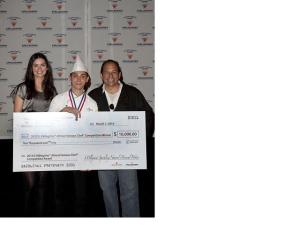The North Miami Campus Library would like to congratulate culinary student Luis Young for winning the the 8th AnnualS. Pellegrino Almost Famous Chef Competition. Luis out cooked 10 other top culinary students from the US, Canada, and Italy for his dish, Herb Scented Venison Tenderloin. To read the Miami New Times interview with Luis, click here.
Culinary Student Wins Big!
March 12, 2010February 4, 2010
Thomas Keller‘s Ad Hoc at home is the chef’s take on classic family meals. As the title suggests,  his newest book is geared more towards home cooks, providing foundational advice on becoming a better cook and accessible recipes. His previous books (The French Laundry Cookbook, Bouchon, and Under Pressure) are esoteric using complicated methods only master chefs with access to equipment like an immersion circulator could replicate. Ad Hoc is a beautiful book inspired by Mr. Keller’s father and the last meal he cooked for him before he died. Ad Hoc is placed on reserve at the North Miami Campus Library.
his newest book is geared more towards home cooks, providing foundational advice on becoming a better cook and accessible recipes. His previous books (The French Laundry Cookbook, Bouchon, and Under Pressure) are esoteric using complicated methods only master chefs with access to equipment like an immersion circulator could replicate. Ad Hoc is a beautiful book inspired by Mr. Keller’s father and the last meal he cooked for him before he died. Ad Hoc is placed on reserve at the North Miami Campus Library.
Haitian Relief LibGuide
January 21, 2010New Video – Job Search in the 21st Century
November 18, 2009A new streamed video has just been added to our Films on Demand database called “Job Search in the 21st Century.” The video is 25 minutes and details how to utilize the Web and social networks to enhance job prospects. To access this video go to the library homepage, select databases from the menu and scroll down to “Films on Demand.” Once you are in the database do a title search for “Job Search in the 21st Century.”
Farewell Gourmet
October 14, 2009Gourmet magazine announced earlier this month that the November issue will be its last. Publisher Conde Nast has decided to pull the plug on the iconic magazine after months of falling ad revenues.
The magazine has been in publication since December of 1940 and has approached the subject of food as culture ever since. The magazine has featured such writers as Juno t Diaz, winner of the 2008 Pulitzer Prize for The Brief Wondrous of Oscar Wao, David Foster Wallace and Anthony Bourdain.
t Diaz, winner of the 2008 Pulitzer Prize for The Brief Wondrous of Oscar Wao, David Foster Wallace and Anthony Bourdain.
The Johnson & Wales North Miami Library retains Gourmet magazine from 1964 to the last issue.
eBook – The American History Cookbook
September 24, 2009The American History Cookbook by Mark Zanger covers a wide range of American history cookery from the pre-colonial to school lunches. Many of the recipes were selected from historical cookbooks with the intention to illuminate techniques used by the people of the time, and thus history. The book is arranged chronologically by time periods (50 Chapters in total) and each chapter opens with a brief historical background then gives a typical recipe of that period. The recipes include detailed instructions on how to prepare the dish authentically with instructions for substitutes for hard to find ingredients and difficult techniques.

The American History Cookbook is available as an eBook through Greenwood Digital Collection database. To access this resource go to the library homepage, select databases, then scroll down to Greenwood Digital Collection and choose your location (either on or off campus). Once you are in the database, click on “American History” subject heading to expand your options, then expand “American History (General)” and you’ll see The American History Cookbook.
Using the Content Specific Search form in LexisNexis
April 24, 2009In my last post about LexisNexis, I talked about using the General Search forms and the Power Search forms. You may also use the Content Specific Search forms which give you more control than the Easy search form and are simpler to use than the Power Search. The Content Specific Search is designed to search a particular type of information such as News or Business.
Let’s go through an example. When you enter the LexisNexis database, you will notice tabs at the top left of the screen. Click on any of the tabs to utilize the Content Specific Search forms. For instance, you need to search trade journals on the government regulation of the financial industry. Select the News tab and enter the words in the search box just as you would on the other search forms. You can either use the Natural Language setting, or Terms and Connectors setting. If you are comfortable using Boolean search strategies such as “and”, “or”, and “not”, use the Terms and Connectors setting as you would when using the Power Search form. In this case, our search phrase is “government regulation of the financial industry” and we are under the Natural Language setting. Next we will add index terms, which are listed by category, by expanding the options under “Add index terms”. You can select up to ten terms to add to your search. Lets add to our search “Banking and Finance” under the Industry category; “Business Forecasts” and “Business Operations” under the Subject or Section category; and “United States” under the Region category. Next, we will select a source for our search by choosing one from the Sources drop-down list. In this search, we will choose “Business News Publications” from the drop-down list. The last step is to choose a date range for our search. A good range for our topic is the “previous 3 months”. Finally, click on the search button located to the right of the search box to run our search.
This search yielded too many results, but we still have options to limit our results. Since we need trade journals for our sources, we can select “Industry Trade Press” under the groups on the left hand side of the screen. Now our results are all from industry trade journals and specifically address government regulation of the recent bailouts, executive compensation, legislation, etc.
I hope have you enjoyed this brief tutorial about using the Content Specific Search form in LexisNexis. Please feel free to leave any comments or questions.
Getting to Know LexisNexis
February 27, 2009Many times students will use Academic Search Premier as their primary database when starting research due to its multi-disciplinary scope. Our campus also subscribes to LexisNexis, another multi-discipline database that provides access to full-text news, business, and legal publications. Apprehension of use by students may stem from the unfamiliar format that the database defaults to when accessed. By learning how to navigate through the interface using a few tricks, students will have yet another powerful database to access for their research.
LexisNexis defaults to a “general search” form, which is geared toward a simple query and searches across the most popular content. You may want to start your research here if you are not sure which sources to use. The “general search” automatically incorporates terms and connectors (Boolean operators such as “and” and “or”) based on what was entered. Simply type in a few words or short phrases that describes your topic, then click the search button. Using this feature will often yield hundreds of results.
The “power search” has many advantages, and I urge students to view the tutorials available on the left hand side of the screen to learn more. One main advantage of the “power search” is that you can choose between terms and connectors or natural language. Select terms and connectors to retrieve more specific information such as a relationship between the search words entered, comprehensive coverage of an issue, or specific information in a document. It is best to select natural language when the topic is more conceptual than specific or when a search is complex and you are uncertain which terms to use.
LexisNexis offers a variety of search options. At the top of the search page there are several category tabs, each designed to search a particular type of content. There is a news tab which can be used to search within a specific source, the New York Times for example. The legal tab allows you to search search within law review journals, federal and state cases or codes, tax law, and international legislation. Under the business tab you can search for information such as corporate news, financial and business information for specific companies. Finally, use the people tab to search for biographical information about individuals using the biographical search form.
I’ve have just briefly touched on a few of the basic features of LexisNexis. I suggest that you experiment with some of the options I have discussed above to get familiar with LexisNexis, then take the tutorials. Over the next several weeks I will highlight specific features within LexisNexis. If there is a specific feature you would like me to discuss, please add a comment or question. LexisNexis is just another powerful tool the library offers that can empower you to effectively access the information you need to succeed in the academic and professional world.
Trade Magazine Update: Pastry Arts & Design & Chocolatier
December 17, 2008
Recently Pastry Art & Design, Chocolatier and Frozen Desserts magazines combined to create Dessert Professional magazine. The magazine is a valuable resource for Baking and Pastry Arts students. Readers will find a wide array of information from news, trends, business profiles, equipment reviews, featured chefs and recipes applicable for the pastry and dessert professional. The magazine is published six times per year and can be found alphabetically in the magazine and journal display under “Dessert.”
The magazine also offers a Social Networking web site with forums, blogs, event postings, group and personalized pages, and a photo gallery, among other tools, for those interested in the Arts of Desserts. An embeddable web banner application that can be added to your web site, Facebook or Myspace page is offered as well. The site can be found at http://www.dessertprofessional.com/.
Student Voting Rights
October 8, 2008There has been some talk of partisan groups badgering voters at the polls on Election Day. The radio program “Fresh Air” aired a program Wednesday, 10/8/08, on voter intimidation that was very interesting. I didn’t catch the whole program, so I decided to look into it more via the web. I came across a link regarding student voting rights that I thought I’d share with you, the students.
The site is by the Brennan Center for Justice at New York University School of Law. It is a very informative site regarding the policies and procedures for students who are attending college outside their home state. If you are not a Florida resident that does not mean you cannot vote! You can look up the state from which you are from on the map, and the site will generate an easy to follow report on the most common rules that apply to you as a student voter. Visit the site, know your rights, and don’t let anyone tell you that you cannot vote!
For a complete write-up on your state’s regulations, please visit: http://www.brennancenter.org/studentvoting. If the link does not work, copy and paste the address to your browser’s url bar.



 Posted by Chris Cannella, Reference Librarian
Posted by Chris Cannella, Reference Librarian